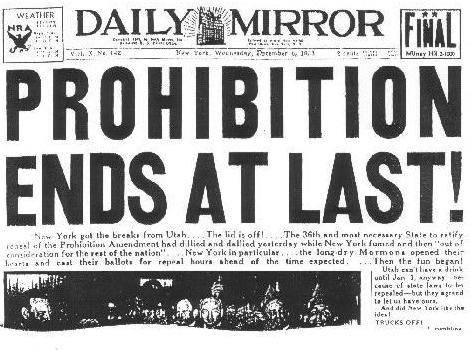It may seem like an enormous amount of whiskey is being produced in the United States right now. That may be true, but we’re only just catching up to production levels before that great, failed experiment of Prohibition. In 1911, about 105 million gallons (400 million liters) of whiskey were produced. The highest level of whiskey production was reached in the 1951 at about 212 million gallons. It will take a lot more whiskey to reach that amount again!
At the end of Prohibition, there were only about one million gallons of aged whiskey stocks in storage warehouses. The American public was consuming about 100 million gallons a year of spirits! Most whiskey producers could not afford to return to the market, so the few companies that were financially viable in the early 1930’s got right to work. In 1933, Schenley (1/4 of the U.S. whiskey market) and National Distillers (1/2 of the U.S. whiskey market) had made an additional 20 million gallons of new make spirit and were working on about 3.5 millions more per month. That paltry amount of new distilled spirit would be blended with remaining stocks to produce whiskeys that would not begin to compare in quality to those properly aged straight whiskeys that people remembered drinking before Prohibition.
“ Maybe one-fourth of it was whiskey, maybe less. It was this technique of the pre-prohibition whiskey men that the bootleggers borrowed and, more precise in their diction, termed cutting. And so the post-prohibition whiskey men can stretch their supply. One part whiskey to four parts of alcohol and water will make a drink that might not satisfy a Kentucky Colonel but will be plenty good enough for you. One part whiskey to nine parts of alcohol and water will make a pretty good beverage. And two or three gallons of good old whiskey plus a couple of gallons of new whiskey plus forty-five gallons of alcohol and water will make a barrel of drinkable liquor, although it might also make you belch. The gentlemen of the whiskey business will not hesitate to cut their whiskey, and until production catches up the whiskey business is liable to be pretty much a wholesale application of bootleg methods. Nevertheless, there is enough to go around.” -(Fortune, 1933)
It would take years to produce straight whiskeys that American citizens used to crave, but by then tastes will have shifted, and the preference will become a lighter, “blended” whiskey. Prohibition knocked the demand for older, more flavorful whiskeys out of the market and even lighter (in flavor) drinks would become popular…here comes vodka! Thank goodness tastes have changed again!

